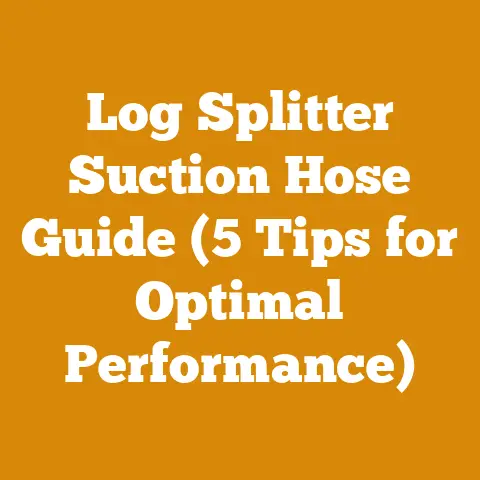Log Cabin Footings Explained (5 Pro Tips for Solid Wood Foundations)
Building a log cabin is a dream for many, a return to nature, a symbol of self-sufficiency.
But before you even start thinking about dovetail joints and chinking, you need a solid foundation.
A shaky foundation will spell disaster for your log cabin, leading to structural problems, rot, and a whole host of headaches.
That’s why understanding log cabin footings is absolutely critical.
I’ve seen firsthand the heartache of poorly planned foundations on log structures, and I’m here to guide you through the essentials.
In this article, I will share my knowledge and experience, breaking down the complexities of log cabin footings and providing actionable insights to ensure your dream cabin stands the test of time.
We will delve into the crucial aspects, from understanding soil conditions to choosing the right footing type and calculating the costs involved.
This is about more than just pouring concrete; it’s about building a legacy.
Why Your Log Cabin Footings Matter More Than You Think
A log cabin’s foundation is the unsung hero.
It bears the entire weight of the structure, protects against moisture, and anchors it to the ground.
Without proper footings, your cabin is vulnerable to:
- Settlement Issues: Uneven settling can cause cracks in the logs, doors and windows to jam, and even structural collapse.
- Moisture Damage: Direct contact with the ground invites moisture, leading to rot, mold, and insect infestations.
This is especially crucial as logs are prone to absorbing moisture. - Frost Heave: In colder climates, the ground freezes and expands, potentially lifting and cracking your foundation.
- Soil Erosion: Over time, soil can erode around the foundation, weakening its support.
I remember a project in the Appalachian Mountains where a client tried to cut corners on the foundation.
Within a few years, the cabin started to lean, and the repairs cost significantly more than doing it right the first time.
Don’t make the same mistake.
5 Pro Tips for Solid Log Cabin Footings
Here are five essential tips to ensure your log cabin has a rock-solid foundation:
1. Know Your Soil: The Foundation of Your Foundation
Before you even think about concrete, you must understand your soil.
Soil composition directly impacts the type and design of your footings.
- Soil Testing: This is non-negotiable.
Hire a geotechnical engineer to perform a soil test.
This will reveal the soil type (clay, sand, silt, gravel), its bearing capacity (how much weight it can support), and the water table level.
Expect to pay between $500 and $1,500 for a professional soil test, depending on the complexity and location. - Understanding Soil Types:
- Clay: Expands when wet, shrinks when dry.
Poor drainage.
Requires wider, deeper footings. - Sand: Excellent drainage, good bearing capacity.
Easier to work with. - Silt: Holds water, can be unstable.
Requires careful compaction and drainage. - Gravel: Excellent drainage, high bearing capacity.
Ideal for foundations. - Loam: A mix of sand, silt, and clay.
Generally good for foundations if properly prepared.
- Clay: Expands when wet, shrinks when dry.
- Bearing Capacity: This is measured in pounds per square foot (psf).
Your footings must be designed to distribute the weight of the cabin within the soil’s bearing capacity.
The soil test report will provide this crucial information.
Example: Let’s say your soil test reveals a bearing capacity of 2,000 psf.
Your cabin’s total weight is estimated at 100,000 pounds, and the perimeter is 100 linear feet.
You’ll need to design your footings to have a minimum width to distribute the load adequately.
This calculation ensures the load doesn’t exceed the soil’s capacity.
2. Choosing the Right Footing Type: Tailoring to Your Needs
There are several types of footings suitable for log cabins, each with its pros and cons:
- Concrete Slab: A solid concrete pad.
Best for stable soil and smaller cabins.
Can be prone to cracking if not properly reinforced.- Cost: $5 – $10 per square foot, including materials and labor.
- Poured Concrete Footings with Stem Walls: A traditional method.
Deep footings below the frost line with concrete walls extending above ground.
Excellent for all soil types and cabin sizes.- Cost: $15 – $30 per linear foot, including materials and labor.
This can vary widely based on the depth of the footing and the height of the stem wall.
- Cost: $15 – $30 per linear foot, including materials and labor.
- Pier and Beam: Concrete piers extending below the frost line, supporting wooden beams.
Good for uneven terrain and areas with poor drainage.- Cost: $20 – $40 per pier, including materials and labor.
The total cost depends on the number of piers required.
- Cost: $20 – $40 per pier, including materials and labor.
- Slab on Grade with Frost Protected Shallow Foundation (FPSF): An insulated slab designed to prevent frost heave in cold climates.
- Cost: $8 – $15 per square foot, including insulation and labor.
- Precast Concrete Footings: Ready-made concrete blocks that can be quickly installed.
Suitable for smaller cabins and DIY projects.- Cost: $50 – $150 per footing, depending on size and load capacity.
Consider these factors when choosing:
- Soil Conditions: As discussed, soil type is paramount.
- Cabin Size and Weight: Larger cabins require more robust footings.
- Climate: Frost depth is a critical consideration in cold climates.
- Budget: Costs vary significantly between footing types.
- DIY vs. Professional: Some footing types are easier to install yourself than others.
I have found poured concrete footings with stem walls to be the most reliable option for most log cabins, offering the best combination of strength, durability, and adaptability.
3. Understanding Frost Depth: A Cold Climate Essential
In regions with freezing temperatures, frost depth is a crucial factor in footing design.
- What is Frost Depth? The maximum depth to which the ground freezes in winter.
- Why it Matters: If your footings are not below the frost line, the freezing and thawing of the ground can lift and crack them, leading to serious structural damage.
- Finding Frost Depth: Local building codes specify the required frost depth for your area.
You can also consult with local contractors or building officials. - Cost Implications: Deeper footings require more excavation, concrete, and labor, increasing the overall cost.
Example: If your local frost depth is 36 inches, your footings must extend at least 36 inches below the ground surface.
It’s a good idea to add a few extra inches for safety.
4. Proper Drainage: Keeping Water Away
Water is the enemy of any foundation.
Proper drainage is essential to prevent moisture damage and soil erosion.
- Grading: Ensure the ground slopes away from the cabin to direct water away from the foundation.
- Drainage Systems: Install French drains (perforated pipes surrounded by gravel) around the perimeter of the foundation to collect and redirect water.
- Cost: $10 – $20 per linear foot, including materials and labor.
- Waterproofing: Apply a waterproof membrane to the exterior of the foundation walls to prevent moisture from penetrating the concrete.
- Cost: $3 – $5 per square foot, including materials and labor.
- Gutter Systems: Install gutters and downspouts to collect rainwater from the roof and direct it away from the foundation.
- Cost: $5 – $15 per linear foot, including materials and labor.
I’ve seen cabins where poor drainage led to water pooling around the foundation, causing significant damage over time.
Investing in proper drainage is a small price to pay for long-term protection.
5. Reinforcement is Key: Ensuring Strength and Durability
Concrete is strong in compression but weak in tension.
Reinforcement with steel rebar is essential to provide tensile strength and prevent cracking.
- Rebar Size and Spacing: The size and spacing of the rebar will depend on the footing type, soil conditions, and cabin weight.
Consult with a structural engineer or building inspector for specific requirements. - Rebar Installation: Ensure the rebar is properly tied together and positioned within the concrete before pouring.
- Cost: Rebar typically adds 10-15% to the overall cost of the concrete work.
Example: For a poured concrete footing, you might use #4 rebar (1/2 inch diameter) spaced 12 inches apart.
Log Cabin Footing Cost Breakdown: A Deep Dive
Now, let’s get down to the nitty-gritty: the cost.
Building a log cabin is a significant investment, and understanding the costs associated with the foundation is crucial for budgeting.
Remember, these are estimates, and actual costs can vary depending on location, materials, and labor rates.
Factors Affecting Cost:
- Location: Labor and material costs vary significantly between regions.
- Soil Conditions: Poor soil requires more extensive site preparation and footing design.
- Frost Depth: Deeper footings cost more.
- Footing Type: As discussed, different footing types have different costs.
- Accessibility: Difficult access to the site can increase labor costs.
- DIY vs.
Professional: Hiring a contractor will increase labor costs but can save you time and ensure the job is done correctly. - Permits: Building permits are required for most foundation work and can add to the overall cost.
Permit costs vary widely depending on location.
Expect to pay anywhere from $200 to $2,000 for permits.
Detailed Cost Breakdown (Poured Concrete Footings with Stem Walls):
Let’s assume a cabin with a 30ft x 40ft rectangular footprint (140 linear feet of foundation) and a frost depth of 36 inches.
Important Notes:
- Concrete Costs: Concrete prices can fluctuate significantly. Call local suppliers for current pricing.
- Labor Costs: Labor rates vary widely depending on location and the contractor’s experience.
Get multiple quotes. - DIY Savings: If you’re comfortable with DIY, you can save significantly on labor costs.
However, foundation work is complex and requires skill and experience. - Contingency: Always include a contingency budget to cover unexpected costs.
Additional Cost Considerations:
- Site Preparation: Clearing trees, removing rocks, and leveling the ground can add to the cost.
- Retaining Walls: If your site has a steep slope, you may need to build retaining walls, which can be expensive.
- Access Roads: If your site is not easily accessible, you may need to build a temporary access road, which can add to the cost.
Cost Optimization Strategies: Saving Money Without Cutting Corners
Building a solid foundation doesn’t have to break the bank.
Here are some strategies to optimize costs without compromising quality:
- Get Multiple Quotes: Obtain quotes from several contractors and compare their prices and services.
- Negotiate Prices: Don’t be afraid to negotiate prices with contractors and suppliers.
- DIY Where Possible: If you’re comfortable with DIY, you can save on labor costs by doing some of the work yourself (e.g., excavation, backfilling).
However, be realistic about your skills and experience. - Value Engineering: Work with your contractor to find cost-effective solutions without compromising quality.
For example, you might be able to use a less expensive type of concrete or rebar. - Time of Year: Concrete prices are often lower in the off-season (e.g., winter in some climates).
- Material Sourcing: Explore local suppliers for competitive pricing on materials.
Sometimes buying directly from the manufacturer can save money. - Optimize Design: A simpler foundation design can reduce material and labor costs.
Consult with an engineer or experienced builder to explore design options.
I once helped a client save several thousand dollars by suggesting a slight modification to the foundation design that reduced the amount of concrete required.
Practical Calculations and Formulas
Here are some useful calculations to help you estimate material quantities and costs:
- Concrete Volume:
- For rectangular footings: Volume (cubic feet) = Length (feet) x Width (feet) x Depth (feet)
- Convert cubic feet to cubic yards by dividing by 27 (1 cubic yard = 27 cubic feet)
- Rebar Quantity: This is more complex and depends on the rebar size, spacing, and footing dimensions.
Consult with a structural engineer or use online rebar calculators. - Drainage Gravel Quantity:
- Estimate the volume of gravel needed based on the trench dimensions and the desired gravel depth.
Example:
Let’s say you need to pour a concrete footing that is 10 feet long, 2 feet wide, and 1 foot deep.
- Volume = 10 ft x 2 ft x 1 ft = 20 cubic feet
- Cubic yards = 20 cubic feet / 27 cubic feet/yard = 0.74 cubic yards
Case Studies: Real-World Examples
Let’s look at a couple of case studies to illustrate the cost variations and challenges:
Case Study 1: Mountain Cabin in Colorado
- Location: Rocky Mountains, Colorado
- Cabin Size: 24ft x 36ft
- Soil Conditions: Rocky soil with poor drainage
- Frost Depth: 48 inches
- Footing Type: Poured concrete footings with stem walls
- Challenges: Difficult access, rocky soil, deep frost depth
- Total Cost: \$25,000 (including site preparation, excavation, materials, labor, and permits)
Case Study 2: Rural Cabin in Georgia
- Location: Rural Georgia
- Cabin Size: 20ft x 30ft
- Soil Conditions: Sandy soil with good drainage
- Frost Depth: 12 inches
- Footing Type: Concrete slab
- Challenges: None
- Total Cost: \$8,000 (including site preparation, materials, labor, and permits)
These case studies highlight the significant cost variations depending on location, soil conditions, and other factors.
Actionable Takeaways and Next Steps
Building a solid foundation for your log cabin is an investment in its long-term durability and value.
Here are the key takeaways and next steps:
- Prioritize Soil Testing: Don’t skip this crucial step.
- Choose the Right Footing Type: Consider your soil conditions, cabin size, and budget.
- Understand Frost Depth: If you live in a cold climate, ensure your footings are below the frost line.
- Ensure Proper Drainage: Protect your foundation from water damage.
- Reinforce with Rebar: Provide tensile strength and prevent cracking.
- Get Multiple Quotes: Compare prices and services from different contractors.
- Plan Your Budget Carefully: Include a contingency for unexpected costs.
- Consult with Professionals: Don’t hesitate to seek advice from structural engineers, building inspectors, and experienced contractors.
Next Steps:
- Contact a geotechnical engineer to schedule a soil test.
- Research local building codes and permit requirements.
- Get quotes from several contractors for foundation work.
- Develop a detailed budget that includes all costs.
- Start planning your log cabin foundation!
Conclusion: Building a Legacy
Building a log cabin is a rewarding experience, but it requires careful planning and execution.
Your cabin’s foundation is the foundation of your dream.
By understanding the principles of log cabin footings and following these pro tips, you can ensure that your cabin stands strong for generations to come.
Don’t cut corners on the foundation.
It’s the most important investment you’ll make in your log cabin.
Remember, building a cabin is not just about constructing a structure; it’s about building a legacy.






